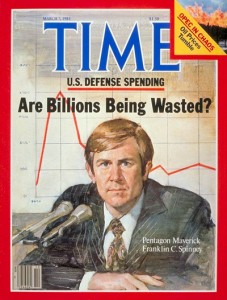
The acid test of any scientific theory is whether or not its predictions reasonably match up to reality. The attached paper by Dr. David Evans is important because it compares predictions of climate models predicting global warming to our most advanced temperature measurement technologies. This is a good example of the kind of information that should be shaping the global warming debate.
The task facing scientists who disagree with this analysis is simple, because this author is up front with his information. His data is sourced and logical descriptions of the models he is testing are clear. The prediction/reality mismatch information shown in this paper is can be replicated and tested for falsification. All one has to do is show why the data is wrong, misleading, or improperly interpreted, or why his logic is wrong — no name calling is needed in what is clearly grist for an honest scientific exchange.
Chuck Spinney
Who Are You Going To Believe – The Government Climate Scientists or The Data?
By Dr David M.W. Evans (republished here with permission, PDF link below)
We check the main predictions of the climate models against the best and latest data. Fortunately the climate models got all their major predictions wrong. Why? Every serious skeptical scientist has been consistently saying essentially the same thing for over 20 years, yet most people have never heard the message – here it is, put simply enough for any lay reader willing to pay attention.
What the Government Climate Scientists Say

Figure 1: The climate models. If the CO2 level doubles (as it is on course to do by about 2070 to 2100), the climate models estimate the temperature increase due to that extra CO2 will be about 1.1°C × 3 = 3.3°C.i
The direct effect of CO2 is well-established physics, based on laboratory results, and known for over a century.ii
Feedbacks are due to the ways the Earth reacts to the direct warming effect of the CO2. The threefold amplification by feedbacks is based on the assumption, or guess, made around 1980, that more warming due to CO2 will cause more evaporation from the oceans and that this extra water vapor will in turn lead to even more heat trapping because water vapor is the main greenhouse gas. And extra heat will cause even more evaporation, and so on. This amplification is built into all the climate models.iii The amount of amplification is estimated by assuming that nearly all the industrial-age warming is due to our CO2.
The government climate scientists and the media often tell us about the direct effect of the CO2, but rarely admit that two thirds of their projected temperature increases are due to amplification by feedbacks.
What the Skeptics Say

Figure 2: The skeptic’s view. If the CO2 level doubles, skeptics estimates that the temperature increase due to that extra CO2 will be about 1.1°C × 0.5 ≈ 0.6°C.iv
The serious skeptical scientists have always agreed with the government climate scientists about the direct effect of CO2. The argument is entirely about the feedbacks.
The feedbacks dampen or reduce the direct effect of the extra CO2, cutting it roughly in half.v The main feedbacks involve evaporation, water vapor, and clouds. In particular, water vapor condenses into clouds, so extra water vapor due to the direct warming effect of extra CO2 will cause extra clouds, which reflect sunlight back out to space and cool the earth, thereby reducing the overall warming.
There are literally thousands of feedbacks, each of which either reinforces or opposes the direct warming effect of the extra CO2. Almost every long-lived system is governed by net feedback that dampens its response to a perturbation. If a system instead reacts to a perturbation by amplifying it, the system is likely to reach a tipping point and become unstable (like the electronic squeal that erupts when a microphone gets too close to its speakers). The earth’s climate is long-lived and stable— it has never gone into runaway greenhouse, unlike Venus — which strongly suggests that the feedbacks dampen temperature perturbations such as that from extra CO2.
What the Data Says
The climate models have been essentially the same for 30 years now, maintaining roughly the same sensitivity to extra CO2even while they got more detailed with more computer power.
- How well have the climate models predicted the temperature?
- Does the data better support the climate models or the skeptic’s view?
Air Temperatures
One of the earliest and most important predictions was presented to the US Congress in 1988 by Dr James Hansen, the “father of global warming”:

Figure 3: Hansen’s predictionsvi to the US Congress in 1988, compared to the subsequent temperatures as measured by NASA satellitesvii.
Phi Beta Iota: The New Craft of Intelligence restores integrity to the process of intelligence. There are no governments, corporations, or universities today actually committed to the whole truth and nothing but the truth. Everyone is isolated in little stove-pipes that allow good people to be doing good things, when in the aggregate they are simply perpetuating huge lies against the public interest. This is the challenge of our times.
See Also:



